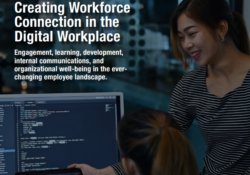We recently reached out to a few long time members of the IHRIM association (including one of the Founders, Sid Simon) to get their impressions of the many changes in HR, HR Technology, and our association. Since there was so much ground to cover and each person had much to contribute, we thought we would format this like a panel discussion. Enjoy the questions, the responses and the trip through history and please provide us your thoughts on what has changed on all fronts.
Our contributors are:
- Sid Simon (SS)
- Marc Miller (MM)
- Freddye Silverman (FS)
- Jim Pettit (JP)
- Nov Omana (NO)
1. What are some of the most dramatic changes you have seen in:
a) The HR function
b) HR Technology
c) The HRIT discipline
- I’m one of those cynical people who has believed over the years that HR, is HR, is HR, as the primary objectives have remained, although programs and approaches oriented to accomplish the objectives have gone through many iterations, often with fancy names to appear they are new and different.How these items are addressed has certainly changed as new technology has offered better and more effective and efficient tools that can be used.Since most corporate executives understand accounting balance sheets, the HR professionals that will be received and communicate well in the executive rooms are those who can present and address their business issues similar to balance sheets.I don’t think a lot needs to be said about the technology – every technology generation has brought new methods/approaches/tools to do things faster, better, and cheaper – although many might debate the “cheaper” item.The HRIT discipline has always been an interesting topic. I have always believed there are specific competencies needed for understanding how a business requirement gets identified, then are translated into a software solution, and ultimately gets implemented. This applies to HR, accounting, manufacturing, etc. – thus having those with the appropriate competencies doing the related work supports the HRIT (and other) disciplines. (SS)
- As we are considering the timeline of 40 years to create the viewpoint of the HR function itself – the simple answer is that since 1980 the responsibilities of the HR function has progressed from focusing on day to day administration and compliance, managing data within a variety of technologies and data bases, to now (within the last 15 years) being a critical component and thus “strategic business partner” to the overall entity in which it operates. Leveraging delivered technology and functionality over the cloud that is in support of literally dozens of functions that would report up to the most senior HR person in a company is the basis for what I call “actionable Insights’ created by all users of the HRMS tool. The resultant initiatives today are more focused than ever before of the well-being and performance of the workforce. The confluence of HRMS providers, Career Management Software providers, overall Talent Management and Learning Management software providers – makes todays HR function within any organization that seeks long lasting success one that will remain critical for the foreseeable future. (MM)
- a) Much more technology savvy and tech-oriented. This was forced on some of the older staffers but has come naturally as they have aged out and younger staff has joined. Besides being HR people, they are employees first, so they like everyone else have their own high expectations of what the company should provide in the way of technology and ease of process.b) The Cloud. Eliminated the cost, time and labor associated with having to own, deploy and support heavy duty and complex internal hardware. Changing providers, while still not a snap, is much more conceivable now, which puts more pressure on vendors to stay top-notch in development, pricing, contracting and customer supportc) There have been a lot of opinions offered that HRIT has worked its way out of a job because HR folks are now more tech-savvy. I don’t think anything could be further from the truth. HRIT always demanded a unique hybrid of skills if it were done right – technology savvy and comfort with change, excellence in communication, project management, user support, presentation skills, budgeting, research, market knowledge and strategic planning, negotiation and contracting skills, etc. – all of which require special attention, training and nurturing in addition to finding those hopefuls who can absorb all of this like sponges and perform accordingly. I don’t think a lot of companies understand that hybrid requirement – it’s always been there but in many businesses HRIT is even today just a data entry/reportwriter/configuration person. To me it’s not a question of how the discipline has changed but whether the true profile required for the discipline has been acknowledged by more companies and responded to. (FS)
- a) Everyone in HR is a consumer, administrator of technology
b) Software as a service changing the influence IT has on selection, deployment and support of HR technology
c) Added complexity in areas expertise/knowledge is required such as data governance, advance reporting/analytics, vendor management, road-mapping and update management. (JP) - a) Rising importance of HR in culture change agent, employee advocacy, awareness of technology as a leverage tool, and increasing closeness to the C-Suite (in not there already)
b) Cycles from ERP BACK to more of a Point Solution HR technology infrastructure as a result of the newer technology capabilities, data transference is slightly easier, the rise (more upheaval) of HR Tech startups, the GREATEST importance on data and its usage in analytics, and the entire world of Artificial Intelligence – which is allowing some terrific insights on trends in the workers and the workplace.
c) As the complexity of vendors, technologies, and capabilities increases, I have seen the HRIT arena morph into less the bridge between IT and HR, to more a “jack of all trades”:- awareness of helping the business and HR leverage tech for driving business goals
- managing the growing and complex vendor world in the HR Tech landscape AND the internal infrastructure
- data governance, standardization, and usage for business analytics
- awareness of the new product capabilities and newer technology approaches
- awareness and dialogue with HR and the business of the newest trends in employee engagement, rewards, measurement, and culture
- technology developments that are peripheral to HR but could and in some cases have impacted HR (wearables, artificial intelligence, block chain)
- ensuring that technology is in compliance with legislation AND moral perspectives (privacy) (NO)
2. What would you identify as some of the hottest technology trends today and why?
- I’m probably not one to be commenting on this topic as what is hot today wasn’t available when I was at the end of my career. My old time hot topic that has become a way of life now is Software as a Service – to me the concept originated with “timesharing” in the 80s (using online reporting) and I unfortunately never realized what it could have become! (SS)
- There are a few significant trends or initiatives that are “top of mind” of both HR leadership and HRMS provider leadership. One significant change in newer HR Technology is the utilization of AI, and built in algorithms to identify “flight risk” within the realm of Talent Management. Another is the ability to capture “sentiment” in the use of the language within workforce emails, ad-hoc survey responses, etc. Both combine to generate “predictive analytics” which allows HR executives to identify “key” employees who might be under rewarded, underappreciated, locked into a position and salary that will make them dissatisfied and ready to seek new positions. (MM)
- AI, Robotics, 3D Printers – all amazing and industry/life-changing in so many ways. I suppose the subdermal personal ID chips should be listed but that’s not a favorite of mine. Way too invasive even if it does make some tasks easier at your company. Also, frankly, the ability to develop apps easily, quickly and cheaply to suit every possible purpose, with simple ways to distribute very broadly. Not new, but still a game-changer. (FS)
- It’s not so much about technology, it the user experience. I for one have no idea all of the technology which is required to order something on Amazon and have it show up at my doorstep the next day, but I do know this user experience is the competition HR strategists face when designing processes and experiences during the acquisition, caring and development of the organization’s human capital. (JP)
- I think assessments these days are becoming one of the hottest and MOST useful tools in the HR arsenal. The sophistication of the assessments, the brevity they require in terms of “taking the survey”, and the depth with which they provide insights to many attributes:
- Personality
- Traits of strength
- Learning style
- Communication style
- Team fit
- Manager fit
- Role/job fit
- Potential for growth in the culture: I believe assessments being used in just the recruitment process is an underutilization, they should be administered to the ENTIRE workforce (employees AND contractors) so that the workforce can be assessed as to fit to job, projects, teams, managers, culture, etc. In my opinion, it is nearly the “holy grail” for HR to use in innovative ways. And this area is getting a LOT of attention by vendors and business as a key to issues like retention, productivity, and measurement. (NO)
3. Are employees more important than HR in serving as consumers of HR technology? Why or why not?
- My take has always been that HR should be providing the tools needed to support businesses plans and programs. Employees today are used to going online to order a product or change their information on a social platform, so changing a home address, entering bank deposit information, registering for a class, aka: the ESS items, as well as the Management items (processing a salary increase, etc.), aren’t a big deal. Certainly these should be offered as efficient and effective approaches to operating an organization. So suppose HR should be taking the lead in providing such, while training and “monitoring” that employees are fulfilling their responsibilities. (SS)
- Employees AND HR are both critical for the potential of any new HR Technology to be fully realized. Capabilities such as ESS / MSS and Manager In-box, effective workflow, dashboards of metrics, intuitive navigation on all devices and various alerts add to the needed “look and feel “ or User Experience (UX) that makes the underlying HR technology part of the critical component of employee engagement. After all – what is the sense of having good HR technology that is not well marketed internally, and then willingly utilized by the workforce? (MM)
- No – I think they are equal client bases in terms of needs and expectations. While self-service touches everyone these days, there are still many parts of an HR system that only managers or admins can and will use. Each customer base has its own requirements and demands and each should have equal support from a technology perspective, regardless of numbers. The biggest difference is that as consumers, HR staff can only yell so loudly. Employees as a group have a much larger voice, as does management – and both vendors and client corporations will respond to the louder voices. (FS)
- Neither, the primary benefactors of HR technology are the business leaders and shareholders who leverage technology to attract, develop and retain the human capital which provides a business and/or competitive advantage in their chosen market. (JP)
- I use the term workforce these days, because employees are a subset of that. But the Employee Experience is a focus of vendors and HR, to make systems easier and more intuitive in the “flow of work”. But I feel a worker is going to be EVERYONE, so I would expect vendors of HR Tech software to ensure that all the ROLES that a worker might play is encompassed in their design as the HR technology is following the worker almost wherever they go. (NO)






